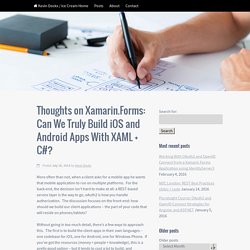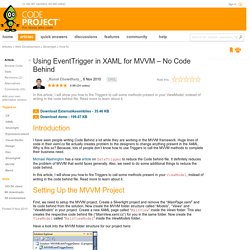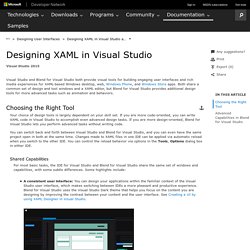

Xamarin Forms. More often than not, when a client asks for a mobile app he wants that mobile application to run on multiple platforms.

For the back-end, the decision isn’t hard to make at all: a REST-based service layer is the way to go, oAuth2 is how you handle authorization. The discussion focuses on the front-end: how should we build our client applications – the part of your code that will reside on phones/tablets? Without going in too much detail, there’s a few ways to approach this. The first is to build the client apps in their own languages – one codebase for iOS, one for Android, one for Windows Phone. If you’ve got the resources (money + people + knowledge), this is a pretty good option – but it tends to cost a lot to build, and especially to support afterwards. So, from that, hybrid apps were born, and those exist in different flavours. One approach here is to use PhoneGap/Cordova. The resulting app isn’t an actual native app: it’s an app that runs your code in an embedded WebView. C# - Why have minimal user/handwritten code and do everything in XAML?
Using EventTrigger in XAML for MVVM – No Code Behind. Introduction I have seen people writing Code Behind a lot while they are working in the MVVM framework.

Huge lines of code in their xaml.cs file actually creates problem to the designers to change anything present in the XAML. Why is this so? Because, lots of people don’t know how to use Triggers to call the MVVM methods to complete their business need. Michael Washington has a nice article on DataTrigger to reduce the Code behind file. In this article, I will show you how to fire Triggers to call some methods present in your ViewModel, instead of writing in the code behind file. Setting Up the MVVM Project First, we need to setup the MVVM project. Have a look into the MVVM folder structure for our project here: Designing XAML in Visual Studio.
Visual Studio and Blend for Visual Studio both provide visual tools for building engaging user interfaces and rich media experiences for XAML-based Windows desktop, web, Windows Phone, and Windows Store apps.

Both share a common set of design and tool windows and a XAML editor, but Blend for Visual Studio provides additional design tools for more advanced tasks such as animation and behaviors. Your choice of design tools is largely dependent on your skill set. If you are more code-oriented, you can write XAML code in Visual Studio to accomplish even advanced design tasks. If you are more design-oriented, Blend for Visual Studio lets you perform advanced tasks without writing code. You can switch back and forth between Visual Studio and Blend for Visual Studio, and you can even have the same project open in both at the same time. For most basic tasks, the IDE for Visual Studio and Blend for Visual Studio share the same set of windows and capabilities, with some subtle differences.
What is XAML? This documentation is archived and is not being maintained.

Extensible Application Markup Language, or XAML (pronounced "zammel"), is an XML-based markup language developed by Microsoft. XAML is the language behind the visual presentation of an application that you develop in Microsoft Expression Blend, just as HTML is the language behind the visual presentation of a Web page. Creating an application in Expression Blend means writing XAML code, either by hand or visually by working in the Design view of Expression Blend.
XAML is part of the Microsoft Windows Presentation Foundation (WPF). WPF is the category of features in the Microsoft .NET Framework 3.5 that deal with the visual presentation of Windows-based applications and Web browser-based client applications. XAML Spy. XAML Spy is the visual runtime inspector for Android, iOS and Windows.

It provides unprecedented access to all aspects of any running app. Interact with the UI visual tree, extract data, explore the filesystem, create stunning artwork, and more, much more. With XAML Spy you will learn about the visual and non-visual behavior of your app at runtime. An important element of XAML Spy is the explorer, delivering a hierarchical realtime view of the various aspects of your connected app. Object details can be explored in the properties window.